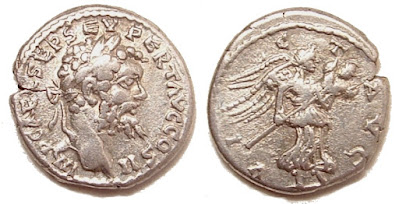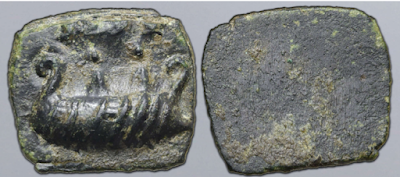Reading
(again) Cathy King’s paper on denarii and quinarii in the late third century in
the 1978 Sutherland festschrift she observes that from the reign of Valerian to
the end of the century their issue was probably restricted to special occasions
with the exception of the denarii of Aurelian and Severina. It is quite
noticeable that in King’s 2007 corpus of Roman quinarii there is an apparent
hiatus in their issue after Claudius II and their issue resumed under Tacitus.
Although not
the sole mint for denarii during the reign of Aurelian the Rome mint is the most
prolific, particularly after the commencement of the 10th issue,
using the arrangement of Estiot in MER XII.1
DENARII OF AURELIAN AND SEVERINA
|
Issue, Date (MER
online) |
Reverse and Issuer |
Notes |
|
1, Oct – Dec 270 |
VICTORIA AVG (Victory right) Aurelian |
|
|
9, summer – autumn 274 |
ORIENS AVG, Aurelian |
Includes a type with left facing martial
bust |
|
10, end 274 (MER XII.1 suggests November to
December) |
VICTORIA AVG (Victory left, with or without
captive) Aurelian |
VSV mark on reverse |
|
VENVS FELIX, Severina |
VSV mark on reverse |
|
|
VENVS VICTRIX, Severina |
VSV mark on reverse |
|
|
LAETITIA AVG, Severina |
VSV mark on reverse |
|
|
11, early 275 to Sep 275 |
ORIENS AVG, Aurelian |
|
|
PROVIDE AVG, Aurelian |
|
|
|
PM TRP VII COS III PP, Aurelian |
|
|
|
VICTORIA AVG (Victory left, with or without
captive) Aurelian |
Right facing consular bust amongst the
obverse types |
|
|
PROVIDEN AVG, Aurelian |
|
|
|
VENVS FELIX, Severina |
|
|
|
12, Sep to Nov 275 |
VENVS FELIX, Severina |
“Interregnum” issue, officina letter in
right field |
The VSV mark
that is present only on the denarius in the series of coins issued by Aurelian
and Severina and only on the denarii of the tenth issue has provoked some
comment in the past. It does not apparently coincide with the monetary reform
of Aurelian that introduced the XXI formula to the radiate base silver coinage
(often termed “aureliani” in academic literature to differentiate the reformed
coins from the pre-reform antoniniani). The aureliani are believed to have started
in issue 8, dating to between spring and summer 274. The usual expansion of VSV
is to “vsvalis”, identifying the coin as the usual accounting unit, ie, the
denarius. If that is the case why is it not present on the issue 9 denarius,
nor perpetuated on later denarii, yet the XXI continued on the radiate coins.
An
attractive alternative solution is that the VSV mark can be expanded to Vota
Solvta Qvinqvenalia, the discharge of the five year vows. This appears
attractive given both the year of issue of the type and also the ephemeral use
of the formula on this brief issue.
Recently a
new theory was put forwards in Num Chron 2013. The VSV formula is postulated to
be a phrase somewhat akin to the RSR (Redeunt Saturnia Regna, the return of the
Saturnian age) on the coins of Carausius. VSV becomes, perhaps, Veniens Sol
Vicit (Sol came and conquered). It echoes the veni, vidi, vici of Julius Caesar,
apt after the defeat of Vabalathus in the east and Tetricus in the west. You
have to ask, though, if that’s the case I would again question why it wasn’t
perpetuated on subsequent issues.
I would
suggest that King’s assertion that the denarii of Aurelian are not ceremonial
issues is not wholly true. The paucity of the earlier issues discounts this.
Also I would argue that the VSV marked pieces are also a ceremonial issue. Even
the last issue of denarii issued during Aurelian’s reign, issue 11, contains a
consular obverse bust type and also a dated reverse type amongst the repertoire
so a ceremonial series may be plausible.
References
Estiot, S,
(MER) Monnaies de l’Empire romain XII.1 d’Aurelien a Florien (2004)
King, C E, “Denarii
and Quinarii, AD 253-295”, in Carson, R A G, and Kraay, C, Scripta Nummaria
Romana: Essays presented to H Sutherland, 1978, pp 75-104
King, C E, Roman
Quinarii from the Republic to Diocletian and the Tetrarchy (2007)
Woods, D,
“Aurelian and the mark VSV: some neglected possibilities “, Numismatic
Chronicle 173, 2016, pp 137-49



























